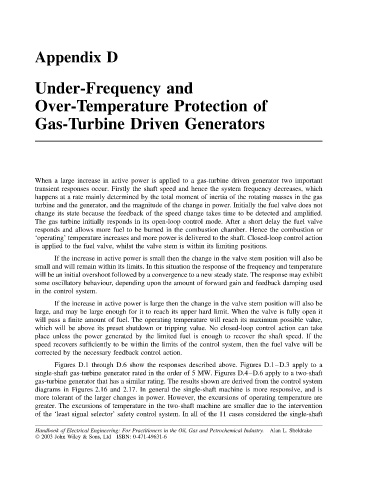Page 548 - Handbook of Electrical Engineering
P. 548
Appendix D
Under-Frequency and
Over-Temperature Protection of
Gas-Turbine Driven Generators
When a large increase in active power is applied to a gas-turbine driven generator two important
transient responses occur. Firstly the shaft speed and hence the system frequency decreases, which
happens at a rate mainly determined by the total moment of inertia of the rotating masses in the gas
turbine and the generator, and the magnitude of the change in power. Initially the fuel valve does not
change its state because the feedback of the speed change takes time to be detected and amplified.
The gas turbine initially responds in its open-loop control mode. After a short delay the fuel valve
responds and allows more fuel to be burned in the combustion chamber. Hence the combustion or
‘operating’ temperature increases and more power is delivered to the shaft. Closed-loop control action
is applied to the fuel valve, whilst the valve stem is within its limiting positions.
If the increase in active power is small then the change in the valve stem position will also be
small and will remain within its limits. In this situation the response of the frequency and temperature
will be an initial overshoot followed by a convergence to a new steady state. The response may exhibit
some oscillatory behaviour, depending upon the amount of forward gain and feedback damping used
in the control system.
If the increase in active power is large then the change in the valve stem position will also be
large, and may be large enough for it to reach its upper hard limit. When the valve is fully open it
will pass a finite amount of fuel. The operating temperature will reach its maximum possible value,
which will be above its preset shutdown or tripping value. No closed-loop control action can take
place unless the power generated by the limited fuel is enough to recover the shaft speed. If the
speed recovers sufficiently to be within the limits of the control system, then the fuel valve will be
corrected by the necessary feedback control action.
Figures D.1 through D.6 show the responses described above. Figures D.1–D.3 apply to a
single-shaft gas-turbine generator rated in the order of 5 MW. Figures D.4–D.6 apply to a two-shaft
gas-turbine generator that has a similar rating. The results shown are derived from the control system
diagrams in Figures 2.16 and 2.17. In general the single-shaft machine is more responsive, and is
more tolerant of the larger changes in power. However, the excursions of operating temperature are
greater. The excursions of temperature in the two-shaft machine are smaller due to the intervention
of the ‘least signal selector’ safety control system. In all of the 11 cases considered the single-shaft
Handbook of Electrical Engineering: For Practitioners in the Oil, Gas and Petrochemical Industry. Alan L. Sheldrake
2003 John Wiley & Sons, Ltd ISBN: 0-471-49631-6

